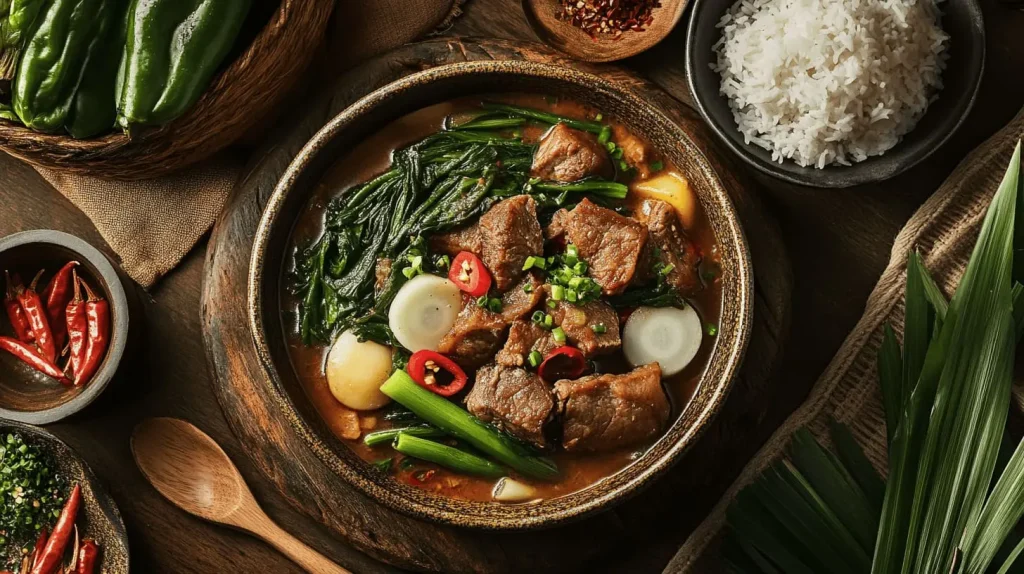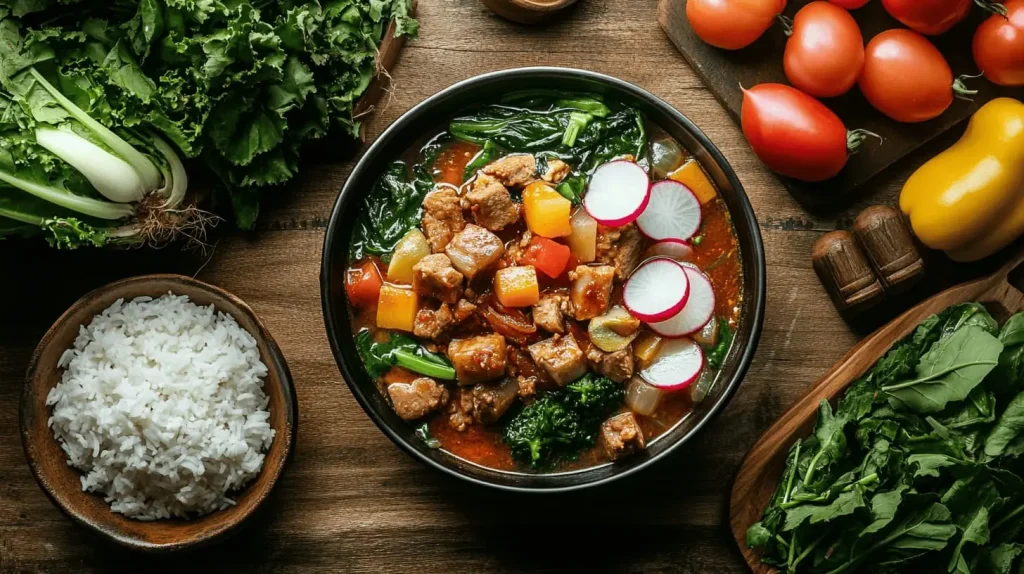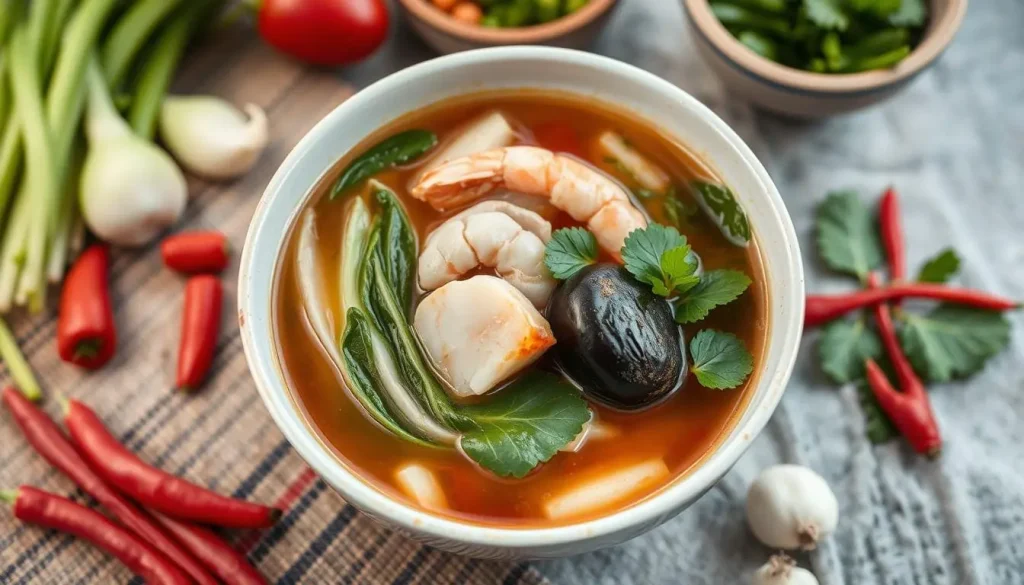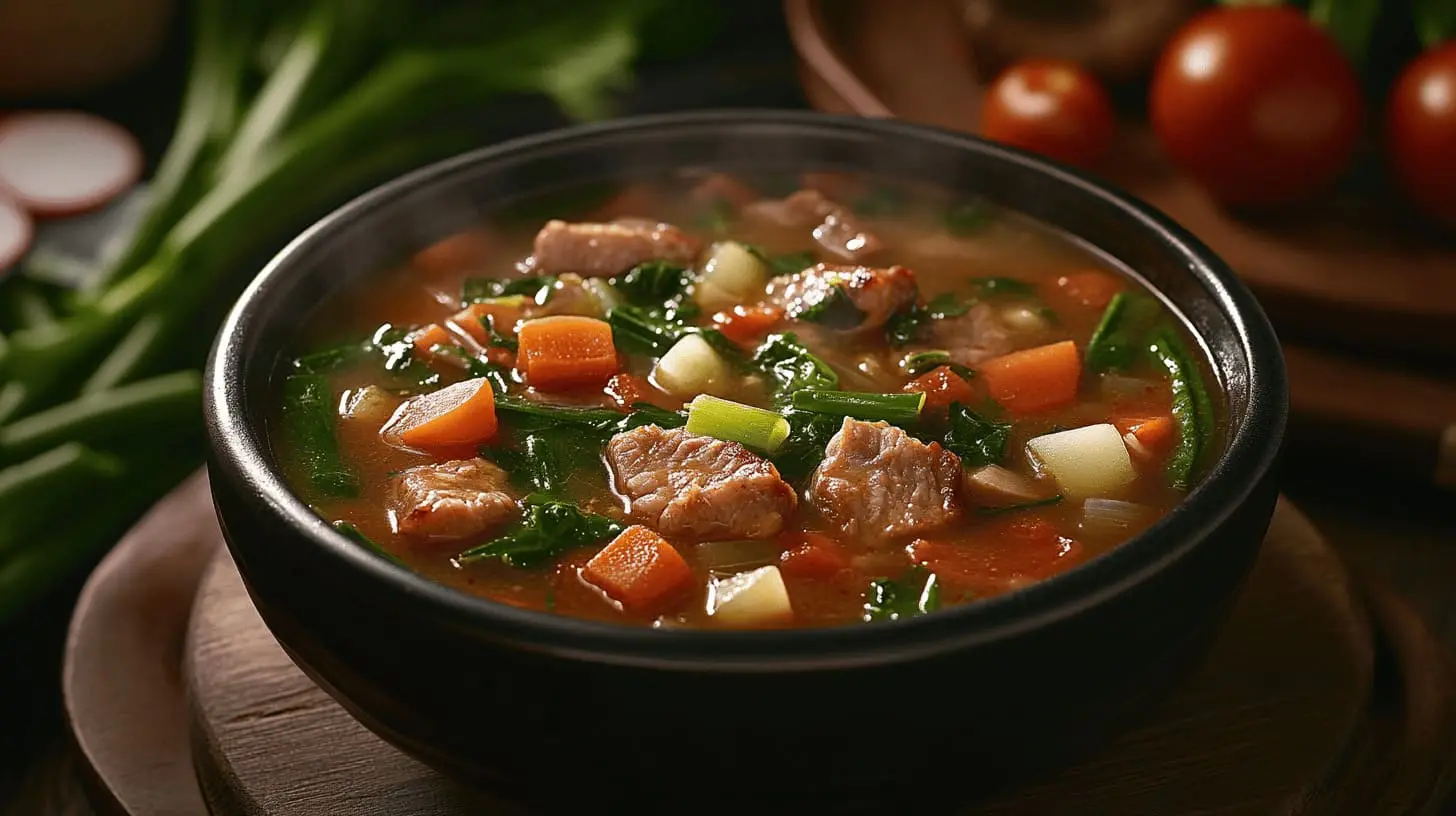Is Filipino sinigang healthy? This tangy tamarind-based soup, cherished in Filipino culture, not only evokes fond childhood memories but also offers numerous health benefits. Let’s explore why sinigang is considered a nutritious and flavorful dish.
I always wondered if sinigang is as healthy as it tastes. In this article, we’ll look into its benefits and nutritional value. We’ll explore its origins, key ingredients, and how it supports a healthy diet.
A steaming bowl of Filipino Sinigang soup, filled with tender pork, vibrant green vegetables like kangkong and radish, sliced tomatoes, and a tangy broth, garnished with fresh herbs, placed on a rustic wooden table with traditional Filipino elements in the background. Warm, inviting colors and a soft focus to enhance the comforting essence of the dish.
Main Highlights
- Is Filipino sinigang healthy? This beloved soup, known for its tangy tamarind base and fresh ingredients, offers a wholesome addition to any meal plan.
- Moreover, it is packed with essential vitamins, minerals, protein, and fiber, making it one of the healthiest Filipino dishes available.
- Ingredients such as garlic, ginger, and lemongrass provide exceptional anti-inflammatory and antioxidant benefits.
- Additionally, in terms of protein, options like pork, fish, or shrimp introduce versatility and nutrition.
- However, managing sodium intake remains crucial, especially for those mindful of their salt consumption.
Understanding Traditional Filipino Sinigang
Filipino cuisine is rich and diverse. Notably, sinigang effectively showcases this culinary heritage.
For instance, its tangy and savory flavor exemplifies the blend of cultural influences that have shaped the Philippines.
Moreover, it offers both exquisite taste and valuable nutrition, making it a staple in Filipino households.
Origins and Cultural Significance
Sinigang’s flavors mix many traditions. Tamarind, from India and Arabia, adds sourness. Fish sauce, from China and Southeast Asia, adds depth.
Basic Ingredients and Preparation
Sinigang combines salty, sour, sweet, and spicy tastes. It has protein like pork or seafood. Fresh veggies like tomatoes and taro add freshness.
The broth is made with water, fish sauce, and tamarind. This makes the dish savory.
Regional Variations
Despite its core, sinigang varies by region. Some use kamias or calamansi instead of tamarind. Others add milkfish or shrimp.
These changes show the dish’s flexibility and the country’s culinary richness.

A vibrant bowl of Filipino sinigang, showcasing the rich, savory broth filled with succulent pork, fresh green vegetables like kangkong and radish, and tangy tamarind, garnished with chili peppers and a side of steamed rice, beautifully arranged on a rustic wooden table.
“Sinigang is one of the most iconic and beloved dishes in Filipino cuisine, with its perfect balance of flavors and ability to adapt to different regional preferences.”
Sinigang is loved for its flavors and cultural value. It delights both locals and visitors. It shows the Philippines’ rich culinary heritage.
Nutritional Profile of Sinigang
Is Filipino sinigang healthy? This delicious and nutritious soup offers a balance of flavors and nutrients.
In fact, a serving of pork sinigang contains about 150-200 calories, along with 20-25g of protein and 5-10g of fat.
Additionally, it provides 2-4g of dietary fiber, supporting a healthy diet.
It’s rich in vitamins and minerals too. For example, a bowl of sinigang gives you 20-25% of vitamin A, 35-50% of vitamin C, 10-15% of iron, and 10-20% of potassium.
The exact amounts can change based on ingredients and serving sizes. Nonetheless, overall, sinigang is a nutritious and balanced meal.
| Nutrient | Amount per Serving | % of RDA |
|---|---|---|
| Calories | 150-200 | – |
| Protein | 20-25g | – |
| Total Fat | 5-10g | – |
| Saturated Fat | 2-4g | – |
| Carbohydrates | 10-15g | – |
| Dietary Fiber | 2-4g | – |
| Vitamin A | – | 20-25% |
| Vitamin C | – | 35-50% |
| Iron | – | 10-15% |
| Potassium | – | 10-20% |
Sinigang is a healthy and tasty Filipino dish. It has the right mix of nutrients for a balanced diet. It’s great for nourishing your body or enjoying a traditional Filipino flavor.

A vibrant bowl of Filipino sinigang placed on a wooden table, surrounded by fresh ingredients like tamarind, greens, radishes, and tomatoes, showcasing the colorful and nutritious components. Include a side of steamed rice and a picturesque view of a tropical kitchen setting with natural light.
Is Filipino Sinigang Healthy: A Detailed Analysis
Filipino cuisine is known for its tasty dishes, and sinigang is a favorite. This sour soup is not just a cultural gem but also good for you. Let’s explore the health perks and nutritional value of this Filipino dish.
Caloric Content and Macronutrients
Sinigang has fewer calories, making it perfect for those on a diet. A serving has about 500 calories. It has a good mix of protein, carbohydrates, and fats.
The protein helps muscles grow and repair. The carbohydrates from veggies and rice give you energy that lasts.
Vitamin and Mineral Content
Sinigang is packed with important vitamins and minerals. It’s full of vitamins A and C, which boost your immune system and skin health. It also has iron and potassium.
Iron helps carry oxygen in your blood. Potassium helps control your blood pressure.
Dietary Fiber Benefits
Sinigang is also rich in dietary fiber from all the veggies. Fiber keeps your digestive system healthy. It helps you stay regular and supports your gut.
In short, sinigang is a healthy and balanced dish. It’s low in calories, full of nutrients, and has lots of fiber. It’s a great choice for a nutritious and tasty Filipino meal.

A vibrant bowl of Filipino sinigang, showcasing its rich broth with fresh vegetables like radish, eggplant, and leafy greens, alongside tender pieces of pork or shrimp. Include nutritional elements represented artistically, such as colorful icons for vitamins and minerals, surrounded by a harmonious layout of ingredients that highlights the dish’s health benefits. The background can feature traditional Filipino textures and colors to enhance cultural richness.
Health Benefits of Tamarind Base
Is Filipino sinigang healthy? One of its main ingredients, tamarind, not only gives the dish its iconic sour taste but also provides numerous health benefits. Packed with antioxidants, tamarind helps combat oxidative stress and may reduce the risk of chronic diseases.
Tamarind is rich in vitamins C and E, as well as phytochemicals. As a result, it helps combat free radicals and keeps cells healthy.
Additionally, its anti-inflammatory properties can reduce swelling and improve overall health when consumed regularly.
Tamarind is also a good source of minerals like magnesium and potassium. Consequently, these help keep blood pressure healthy and support bone health.
Tamarind is great for digestion. It has gentle laxative effects that can ease discomfort. Its natural ability to reduce swelling makes it helpful when included in a healthy diet.
| Nutrient | Amount in Tamarind |
|---|---|
| Vitamin C | Over 25% of the RDA |
| Magnesium | Over 25% of the RDA |
| Potassium | 10-20% of the RDA |
| Iron | 10-15% of the RDA |
The tamarind base in Sinigang is more than flavor. It’s a health powerhouse. It supports overall well-being with its antioxidants, nutrients, and traditional uses.
Protein Sources in Sinigang and Their Benefits
Sinigang is a favorite Filipino soup. It’s great for adding different proteins, each with its own health perks. Pork is full of B vitamins and zinc. But, it has a lot of saturated fats, so watch how much you eat.
Beef is packed with iron and creatine. Creatine helps muscles a lot. For leaner protein, try fish like milkfish or tilapia. They’re full of omega-3s, which are good for your heart.
Seafood Variations
Sinigang is also good with seafood. You can add shrimp or pompano fish. These add more nutrients, but eat them in small amounts because of mercury. Sinigang lets you make a healthy, tasty dish that fits many diets and needs.
| Protein Source | Nutritional Benefits |
|---|---|
| Pork | Rich in B vitamins and zinc, but high in saturated fats |
| Beef | Good source of iron and creatine, beneficial for muscle health |
| Fish (milkfish, tilapia) | Lean protein source, rich in omega-3 fatty acids |
| Seafood (shrimp, pompano) | Provides additional nutrients, but should be consumed in moderation due to potential mercury content |
Vegetable Components and Their Nutritional Value
Sinigang is a tasty and healthy Filipino soup. It has many vegetables that make it nutritious. These veggies add vitamins, minerals, and fiber to the dish.
Eggplant is a key ingredient in sinigang. It’s full of antioxidants like nasunin. These help your brain and heart stay healthy. Tomatoes are also important. They have lycopene, which fights cancer.
- Water spinach, or kangkong, is a nutrient-dense green that is high in vitamins A, C, and K, as well as folate and calcium.
- Radish, with its peppery flavor and crunchy texture, offers a good source of dietary fiber, vitamin C, and minerals like potassium.
- Green beans, a classic sinigang ingredient, provide a dose of vitamin C, vitamin K, and essential B-vitamins.
The veggies in sinigang add flavor and nutrition. They make sinigang a healthy Filipino soup. Enjoying it as a meal or side dish is a treat.
“Sinigang is a culinary treasure trove, where the perfect balance of tangy, savory, and nourishing ingredients come together to create a truly remarkable dish.”
Sodium Content and Health Considerations
Sinigang is a Filipino dish loved for its sour and savory taste. However, it’s important to talk about its sodium content.
A serving of sinigang can have 500-1000 mg of sodium. This comes from tamarind soup base, fish sauce, and shrimp paste.
To reduce sodium, you can use low-sodium ingredients or less of them. For example, using reduced-sodium fish sauce or soy sauce can make a big difference.
By doing this, you can still enjoy sinigang while keeping your sodium intake under control.
Managing Salt Intake
Too much sodium is bad for your health. It can lead to high blood pressure and heart problems. To cut down sodium in sinigang, use low-sodium ingredients or less of them. Making sinigang at home lets you control the sodium better.
Modified Recipes for Low-Sodium Diets
If you’re on a low-sodium diet, you can still enjoy sinigang. Use low-sodium broth or stock as the base. Choose reduced-sodium fish sauce or soy sauce. You can also use calamansi or lemon juice for sourness without sodium.
By choosing the right ingredients and methods, you can enjoy sinigang’s true taste. This way, you can have it as part of a healthy, low-sodium diet.
Antioxidant Properties and Immune Support
Sinigang is more than just a tasty dish. It’s packed with antioxidants from its tamarind base and veggies. These antioxidants protect our cells from harm, boosting health and preventing disease.
The high vitamin C content in sinigang is key. It’s in the tamarind and veggies like tomatoes and onions. Vitamin C helps our immune system fight off sicknesses.
Also, sinigang’s mix of antioxidants and essential nutrients might boost our immune system. Its ingredients work together to give us a big nutritional punch. This helps our body’s defenses and keeps us healthy.
| Ingredient | Antioxidant Benefits | Immune-Boosting Properties |
|---|---|---|
| Tamarind | Rich in vitamin C, polyphenols, and flavonoids | Supports immune function and helps fight infections |
| Tomatoes | High in carotenoids, such as lycopene, which have antioxidant effects | Contain vitamin C, which enhances immune responses |
| Onions | Contains quercetin, a powerful antioxidant that scavenges free radicals | Possess antimicrobial properties that can boost immunity |
| Greens (e.g., spinach, kangkong) | Rich in vitamins, minerals, and phytochemicals with antioxidant abilities | Provide a variety of nutrients that support immune health |
In short, sinigang is good for us. It’s full of antioxidants and immune-boosting components. Eating it can help keep our bodies healthy and strong against harm.
Weight Management and Dietary Benefits
Sinigang, a favorite Filipino soup, is great for weight management. It’s full of water and fiber, making it low in calories. This makes it a filling dish without too many calories.
Choosing lean proteins like fish or shrimp makes sinigang even better. It adds omega-3 fatty acids, good for your heart. The veggies in sinigang, like water spinach and tomatoes, give you vitamins and antioxidants.
Sinigang is not just for weight control. It’s also good for a balanced diet. It’s filling and low in calories, helping you eat less. Enjoying sinigang lets you taste Filipino culture while staying healthy.
FAQ
What are the health benefits of sinigang?
Sinigang is a traditional Filipino soup. It’s low in calories but high in protein, helping with weight management. It’s full of vitamins A and C, which boost your immune system and skin health.
The fiber from vegetables helps with digestion and gut health. It also has minerals like iron and potassium, supporting your body’s functions.
Is sinigang good for your health?
Yes, sinigang is a healthy dish. It has a good mix of nutrients. Tamarind, a key ingredient, is full of antioxidants and has anti-inflammatory properties.
This helps lower the risk of chronic diseases. Plus, it’s packed with vegetables, making it a low-calorie, nutrient-rich option.
What is the nutritional value of Filipino sinigang?
A serving of pork sinigang provides approximately 150-200 calories, along with 20-25g of protein and 5-10g of fat. Additionally, it contains 2-4g of saturated fat and 50-80mg of cholesterol.
This dish also includes 10-15g of carbohydrates, 2-4g of dietary fiber, and 3-5g of sugars. Moreover, it serves as a rich source of essential nutrients like vitamins A and C, iron, and potassium.
What are the key ingredients in traditional Filipino sinigang?
The key components of sinigang are proteins such as pork or fish, accompanied by fresh vegetables like water spinach and tomatoes. Tamarind is used as the primary souring agent, giving the soup its distinctive flavor.
In addition, it features a blend of influences from China, India, Spain, the U.S., and Arabia. Other ingredients include fish sauce, shrimp paste, garlic, and ginger, which enhance its unique taste.
How can sinigang be beneficial for weight management?
Sinigang is high in water and fiber, but low in calories. This makes it a good choice for weight management. It’s filling without being too high in calories.
Choosing lean proteins and more vegetables can make sinigang even better for weight management. It lets you enjoy traditional Filipino cuisine while watching your weight.

